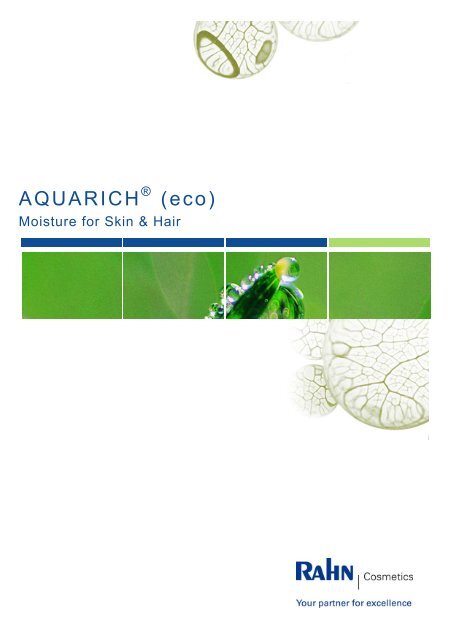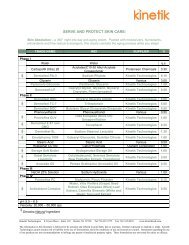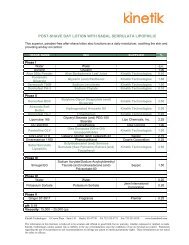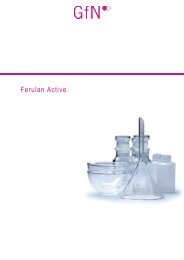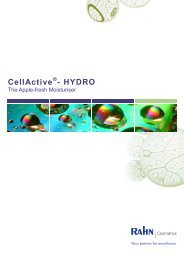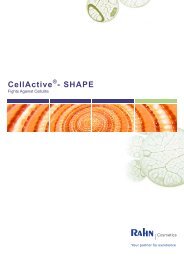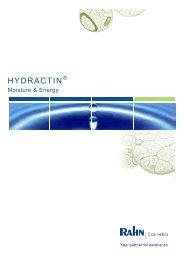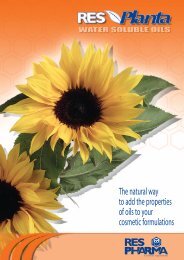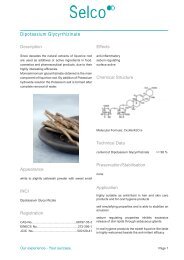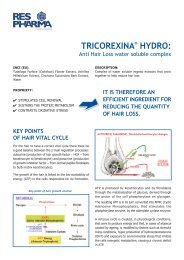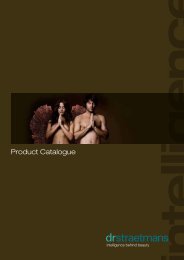AQUARICH (eco) - Kinetik
AQUARICH (eco) - Kinetik
AQUARICH (eco) - Kinetik
You also want an ePaper? Increase the reach of your titles
YUMPU automatically turns print PDFs into web optimized ePapers that Google loves.
<strong>AQUARICH</strong> ®<br />
Moisture for Skin & Hair<br />
(<strong>eco</strong>)
Table of contents<br />
1 General introduction 4<br />
2 The skin and its structure 5<br />
2.1 The skin structure 5<br />
2.2 The cornea layer 5<br />
3 Active substances in <strong>AQUARICH</strong> ® 7<br />
3.1 Black oat (Avena strigosa) 7<br />
3.2 Lecithin fraction 9<br />
3.3 <strong>AQUARICH</strong> ® , a complete concept 10<br />
4 Studies on effectiveness/ Choice of methods/ Results 11<br />
4.1 Determination of effectiveness in-vivo by using Hydrascan ® 11<br />
4.1.1 Description of methods and test conditions 11<br />
4.2 Measuring results after 1, 3, 8 and 24 hours 12<br />
4.2.1 General conditions 12<br />
4.2.2 Measuring results of the upper epidermis layer 12<br />
4.2.3 Measuring results of the middle epidermis layer 12<br />
4.2.4 Measuring results of the lower epidermis layer 13<br />
4.2.5 Summarized results: the entire epidermis 13<br />
4.3 Long-term moisturizing effect of 2% and 4% <strong>AQUARICH</strong> ® 14<br />
5 Application and storage 15<br />
5.1 Summary 15<br />
5.2 Application methods 15<br />
5.3 Origin of the content materials 15<br />
5.4 Storage instructions 15<br />
5.5 Manufacturing notes 15<br />
5.6 R<strong>eco</strong>mmended concentration for use 15<br />
6 Specification 16<br />
6.1 Product specifications 16<br />
7 Registration 17<br />
7.1 Registration and content information 17<br />
7.2 Preservatives 17<br />
8 Toxicology and evaluation of safety 18<br />
8.1 Toxicology 18<br />
8.2 Eco-toxicology 18<br />
8.3 Water endangerment class (German: WGK) 19<br />
8.4 Safety evaluation 19<br />
9 The test emulsions and its effect 20<br />
9.1 Product description 20<br />
Page 2 / 26<br />
<strong>AQUARICH</strong> ®<br />
(<strong>eco</strong>) │ Moisture for Skin & Hair
9.2 Formula number: DAY 0402 20<br />
9.3 Production of the test emulsion DAY 0402 21<br />
9.4 Data on stability 21<br />
9.5 Efficacy of DAY 0402 cream and a comparative cream measured against untreated skin 21<br />
9.5.1 General 21<br />
9.5.2 The moisturizing effect of the test cream with 4% <strong>AQUARICH</strong> ®<br />
9.6 Summary<br />
22<br />
24<br />
10 Bibliography 25<br />
Page 3 / 26<br />
<strong>AQUARICH</strong> ®<br />
(<strong>eco</strong>) │ Moisture for Skin & Hair
1 General introduction<br />
Water – the origin of all life forms!!<br />
The first civilisations developed by the sea. 70% of the surface of the earth is covered with water.<br />
Man consists of 70% water and also the skin can be included in this list<br />
No connection is more important for our existence and our well-being.<br />
Water performs many vital functions in our body. Water is irreplaceable as a means of transport<br />
and a solvent. Water also performs a major function in the regulation of body temperature.<br />
A lack of water not only reduces the physical powers but can, depending on the extent, also lead to<br />
serious damage to one’s health. As little as a 4% lack of water in our body system results in a 25%<br />
reduction in physiological powers. Such a lack of moisture inevitably has an effect on the skin. The<br />
appearance of the skin deteriorates considerably. The first stage is certainly a pale, unhealthy<br />
looking skin, the lack of elasticity can lead to chapping and slow-healing wounds later.<br />
Frequent sunbathing, wind, household work and other environmental influences dry out our skin. As<br />
a result, it loses resiliency and vitality, appearing rough and dry. With increasing age, the skin<br />
renewal cycle slows down, leading to a more sensitive and thinner skin which requires special<br />
protection. Therefore, it is extremely important to maintain a healthy and intact skin barrier, provide<br />
the skin with moisturizing active agents.<br />
For this dry and sensitive skin, RAHN has developed an active agent which sets new, far-reaching<br />
standards through its uniqueness and effectiveness.<br />
Page 4 / 26<br />
<strong>AQUARICH</strong> ®<br />
(<strong>eco</strong>) │ Moisture for Skin & Hair
2 The skin and its structure<br />
2.1 The skin structure<br />
The human skin is the largest organ of our body. It consists of three layers: the epidermis (or<br />
cuticle), the derma (or corium), and the subcutis (or hypodermis).<br />
The skin has to fulfil a great number of tasks. A very interesting composition of the skin is<br />
necessary in order to fulfil these numerous tasks.<br />
Hair<br />
Meissner’s<br />
corpuscles<br />
Epidermis<br />
Cornea layer<br />
Basal layer<br />
Corium<br />
Sebaceous<br />
gland<br />
Smooth muscle<br />
Hair papilla<br />
Subcutaneous<br />
fatty tissue<br />
Fat cells<br />
Nerve<br />
Blood vessels Sweat gland Nerve Pacini’s corpuscles<br />
2.2 The cornea layer<br />
The cornea layer (stratum corneum) plays an<br />
especially important part in the subject of “protection<br />
of the skin“. As the outermost layer of the epidermis,<br />
the cornea forms a sort of barrier stage in the skin. It<br />
is comparable to a wall made of bricks stuck together<br />
with mortar. This “wall” must be kept in perfect<br />
condition so that it can perform its protective<br />
function.<br />
Page 5 / 26<br />
<strong>AQUARICH</strong> ®<br />
(<strong>eco</strong>) │ Moisture for Skin & Hair
Cementsubstance<br />
Horny cells<br />
Water<br />
Lipid<br />
double<br />
layer<br />
The wall-like<br />
structure made of<br />
cornified,<br />
keratinised cells<br />
and cement<br />
substance<br />
prevents, on the<br />
one hand, the<br />
penetration of<br />
foreign and toxic<br />
substances from th<br />
outside and the<br />
exceedingly fast<br />
evaporation of<br />
water out of the<br />
skin on the other<br />
side.<br />
In other words, this cornea layer concerns an enormously important zone for protection and<br />
maintenance of healthy, fully functional skin.<br />
With increasing age, the skin b<strong>eco</strong>mes less elastic and loses suppleness, the cement substance<br />
b<strong>eco</strong>mes brittle, and small gaps form. Water can evaporate through these gaps, and the skin<br />
begins to feels dry and rough. The cell membranes, which mainly consist of lecithin, not only<br />
function as the limits of the cells but also regulate the exchange of substances, activate the<br />
enzymes and transfer of ions as well as the transmission of nerve stimuli. Membranes consist of<br />
30-40% of lecithin (Approx.).<br />
Page 6 / 26<br />
<strong>AQUARICH</strong> ®<br />
(<strong>eco</strong>) │ Moisture for Skin & Hair
3 Active substances in <strong>AQUARICH</strong> ®<br />
3.1 Black oat (Avena strigosa)<br />
From the Far East, very old r<strong>eco</strong>rds exist which prove that oat was cultivated by early civilizations.<br />
Due to its properties as a foodstuff, its triumphal march into our latitudes could not be halted, the<br />
oat also thrived excellently in our climate zones. Oat was planted more and more frequently.<br />
However, the demand for more fertile and more productive kinds of oat has caused the original oat<br />
(Avena strigosa) to vanish into oblivion. Today, mainly Avena sativa, or common oat, is grown.<br />
The genus Avena strigosa is designated as the original oat. Originally<br />
a wild-growing plant, it was laboriously harvested by hand. Due to its<br />
low yield of grain per ear, the search for more productive kinds started<br />
soon and was successful. Nowadays, mainly Avena sativa is<br />
cultivated, which, although has shorter ears than black oat, is much<br />
more productive and is therefore much more interesting for the<br />
industrial countries.<br />
The grain of the black oat purely contains the<br />
unique vigor of the original plant.<br />
Despite adverse conditions, it has managed<br />
to survive until modern times and is revived in<br />
the moisturizer <strong>AQUARICH</strong>®.<br />
It is not surprising that black oat is used in<br />
several dietary supplements for performance<br />
enhancement. Equestrian sport insiders have<br />
used black oat to increase the performance of<br />
race horses by releasing their power reserves<br />
over longer time. In view of this and the fact<br />
that in the top-class sport industry, black oat<br />
is preferably used instead of common oat<br />
(although it is more easily available on the market at lower costs), this speaks for the uniqueness of<br />
the original oat.<br />
This primary source of vitality and vigor contains a wide range of ingredients.<br />
Polysaccharides are the main component of oats. The high content of high-molecular glucose<br />
building blocks is even more important. Particularly the high content of beta glucan in the oat grain<br />
makes it very valuable for cosmetic applications. Thanks to beta glucan, the skin feels soft and<br />
supple and can bind water better. The natural repair and protective function is also optimised by<br />
beta glucan. Due to the existence of various saponins, (avenacin, avenacosid) the oat grain extract<br />
has an antibiotic effect.<br />
In addition, amino acids, the irreplaceable building blocks of living tissue, are present in much<br />
higher concentrations in oat than in other types of cereal. Oat contains all eight essential amino<br />
acids.<br />
Page 7 / 26<br />
<strong>AQUARICH</strong> ®<br />
(<strong>eco</strong>) │ Moisture for Skin & Hair
Amino acid content calculated in % of dry matter<br />
in 100 g of ground grain<br />
Amino acid Oat Barley Corn Wheat Rye<br />
Valine* 0.89 0.50 0.46 0.56 0.53<br />
Leucine* 1.12 0.69 1.16 0.86 0.69<br />
Isoleucine* 0.77 0.42 0.41 0.59 0.43<br />
Methionine* + Cystine 0.54 0.34 0.29 0.48 0.36<br />
Threonine* 0.49 0.33 0.36 0.37 0.37<br />
Phenylanaline* + Tyrosine* 1.35 0.87 0.96 1.11 0.81<br />
Tryptophan* 0.19 0.12 0.055 0.15 0.11<br />
Lysine* 0.55 0.33 0.26 0.35 0.41<br />
Total 5.9 3.6 3.955 4.47 3.71<br />
(Table from: Hafer, Volksnahrung und “Functional Food”, excerpt from speech by Mr. Roehker)<br />
* essential amino acids<br />
The above table shows the superiority of oat in its amino acid content as well as in its selection of<br />
essential amino acids.<br />
Comparison of several cereals based on the content of zinc and manganese in mg/100g in the<br />
whole grain:<br />
Cereals Zinc Manganese<br />
Oat 3.7 4.6<br />
Corn 2.5 0.5<br />
Wheat 3.0 2.4<br />
Rye 1.3 2.2<br />
The very high natural content of the two trace elements zinc and manganese substantiates the<br />
assumption that oat also has anti-oxidative properties. As is known from literature, zinc and<br />
manganese play an important role as catalysts in the prevention of the development of free<br />
radicals.<br />
The original oat dry extract is produced in a specially controlled process, developed especially for<br />
<strong>AQUARICH</strong> ® is particularly rich in the trace elements manganese and zinc and the B group<br />
vitamins.<br />
In cosmetics, oat will surely be applied due to its moisturizing and softening properties.<br />
Page 8 / 26<br />
<strong>AQUARICH</strong> ®<br />
(<strong>eco</strong>) │ Moisture for Skin & Hair
3.2 Lecithin fraction<br />
Lecithin is the collective term for a group of substances (glycoproteins) which are some of the most<br />
important and widespread substances of living nature. All living cells contain lecithin. Lecithins are<br />
present in very high concentrations in pulses (lentils, beans, soy, lupines...). The carbohydrate<br />
content in lecithins ranges from 2 to 50%.<br />
In the 19 th century, lecithin was isolated from egg yolk by<br />
a French chemist for the first time. Lecithin and its various<br />
fractions are known as emulsifiers. Highly purified<br />
fractions are not used for these applications.<br />
A special lecithin fraction, very rich in unsaturated<br />
phospholipids, was selected for <strong>AQUARICH</strong> ® .<br />
Phospholipids are essential components of every cell.<br />
One positive property is that the phospholipids in lecithin<br />
makes the skin supple and soft without feeling greasy. In<br />
addition, it has excellent water binding properties.<br />
Alpha phosphatidylcholine<br />
R: fatty acids<br />
Phosphatidylcholine (PC) is<br />
extracted in a controlled process<br />
from lecithin. Normally, raw<br />
lecithin contains approx. 2% - 3%<br />
PC. The fraction used for<br />
<strong>AQUARICH</strong> ® contains over 70%<br />
PC.Unsaturated phosphatidylcholine<br />
(use in <strong>AQUARICH</strong> ® )<br />
contains the omega 6 fatty acids<br />
essential for humans.<br />
Page 9 / 26<br />
<strong>AQUARICH</strong> ®<br />
(<strong>eco</strong>) │ Moisture for Skin & Hair
Choline-<br />
Serine<br />
Hydrophilic head<br />
group<br />
Phosphates<br />
Glycerin<br />
Hydrophobic end<br />
group<br />
Fatty acids<br />
Fatty acids<br />
3.3 <strong>AQUARICH</strong> ® , a complete concept<br />
‣ The active agents in the black oat extract help to bind moisture into the<br />
skin having a long lasting and vitalising effect.<br />
‣ The special lecithin fraction helps strengthens the structure of the skin<br />
barrier.<br />
‣ The Transepidermal Water Loss (TEWL) value is lowered, moisture in the<br />
skin evaporates more slowly, hydration is clearly sustained which<br />
supports the synergistic effect of phosphatidylcholine and black oats.<br />
Page 10 / 26<br />
<strong>AQUARICH</strong> ®<br />
(<strong>eco</strong>) │ Moisture for Skin & Hair
4 Studies on effectiveness/ Choice of methods/ Results<br />
4.1 Determination of effectiveness in-vivo by using Hydrascan ®<br />
4.1.1 Description of methods and test conditions<br />
The test for determining the moisturizing effect of <strong>AQUARICH</strong> ® was conducted on 15 persons in an<br />
independent testing institute. The test emulsion DAY 0402 (4% <strong>AQUARICH</strong> ® ) was tested against a<br />
placebo and a standard moisturizer (0.1% hyaluronic acid) to determine the moisturizing effect. The<br />
analyses were conducted on the underside of the forearm.<br />
The skin was measured with the Hydrascan ®<br />
application.<br />
at 1h, 3h, 8h and 24h intervals after the last<br />
With the specially developed Hydrascan ® method it is possible to determine the moisture in three<br />
different skin depths. The so-called “Transient Thermal Transfer“ (TTT) enables the measurement<br />
of skin moisture in the epidermis divided into three layers, the upper, middle and lower epidermis<br />
layers.<br />
The Hydrascan ® method is based on thermal conductivity and resistance which after conversion<br />
can be used for determining skin moisture exactly.<br />
The TTT measurement is<br />
based on the combination of<br />
thermal radiation/conductivity<br />
which allows conclusions to be<br />
drawn about the extent of skin<br />
moisture.<br />
The main advantage of this<br />
measuring method is that three<br />
different measuring zones can<br />
be integrated in just one<br />
measurement.<br />
The moisturizing effect of <strong>AQUARICH</strong> ® was determined in the test during 1h, 3h, 8h and 24h on 15<br />
persons.<br />
One hour before the first measurement (D0) the subjects were treated as follows:<br />
• The test persons appeared at the testing institute without pre-treatment of the arms by any<br />
applications<br />
• All subjects were informed about the exact procedure<br />
• Measurement of the zero value with Hydrascan ®<br />
• Application of a standardised amount (2μl/cm 2 ) of the test vehicle<br />
Page 11 / 26<br />
<strong>AQUARICH</strong> ®<br />
(<strong>eco</strong>) │ Moisture for Skin & Hair
4.2 Measuring results after 1, 3, 8 and 24 hours<br />
4.2.1 General conditions<br />
A test emulsion DAY 0402 with 4% <strong>AQUARICH</strong> ® and a comparative emulsion with 0.1% hyaluronic<br />
acid were measured against a placebo. The measurement took place in three different epidermal<br />
layers. Thus the analyses were calculated individually initially and as a complete epidermis<br />
afterwards.<br />
4.2.2 Measuring results of the upper epidermis layer<br />
The <strong>AQUARICH</strong> ® has an improved moisturizing effect in comparison to the hyaluronic acid. Even<br />
after 24 hours, the upper epidermis layer has a higher skin moisture content of +9.6%.<br />
4.2.3 Measuring results of the middle epidermis layer<br />
Unlike the hyaluronic acid, <strong>AQUARICH</strong> ® was able to help maintain a moist skin even after 24 hours.<br />
By increasing skin moisture by +11.6%, <strong>AQUARICH</strong> ® has a very lasting effect and penetrates<br />
deeper into the epidermis.<br />
Page 12 / 26<br />
<strong>AQUARICH</strong> ®<br />
(<strong>eco</strong>) │ Moisture for Skin & Hair
4.2.4 Measuring results of the lower epidermis layer<br />
A very interesting report is that after application of a cream containing 4% <strong>AQUARICH</strong> ® , the skin<br />
moisture continues to exist after 8 respectively 24 hours and has excellent values.<br />
It may be assumed that the improved moisturization of the lower epidermis layer also results from<br />
the optimised barrier function plus the surface-active agents from the black oat.<br />
4.2.5 Summarized results: the entire epidermis<br />
When <strong>AQUARICH</strong> ® is used, an immediate intensive effect is measured after application (after 1<br />
hour => +34%). The moisture level drops as expected after 3 hours. After 8 hours, the intensive<br />
strengthening of the barrier properties of the cornea layer and the moisture-binding active agents in<br />
the black oat b<strong>eco</strong>me more noticeable, as the moisture increases in the entire epidermis. This<br />
moisturizing effect still increases slightly at 24 hours.<br />
Page 13 / 26<br />
<strong>AQUARICH</strong> ®<br />
(<strong>eco</strong>) │ Moisture for Skin & Hair
4.3 Long-term moisturizing effect of 2% and 4% <strong>AQUARICH</strong> ®<br />
After the results of the emulsion DAY 0402 with regards to moisturizing turned out very well, it was<br />
interesting to look at the effects of a lower <strong>AQUARICH</strong> ® (2%) concentration.<br />
The results 24 hours after the last application are given below.<br />
The emulsion with 4% <strong>AQUARICH</strong> ® still shows a remarkable moisturizing effect of 27.8% 24 hours<br />
after the last application.<br />
The analysis of the 2% <strong>AQUARICH</strong> ® emulsion is very interesting. An increase in moisturization of<br />
the epidermis of 6% can be measured 24 hours after the last application.<br />
This measurement shows that <strong>AQUARICH</strong> ® is effective at lower concentrations. Considering the<br />
fact that the comparative emulsion with 0.1% hyaluronic acid had absolutely no more effect after 24<br />
hours, even this result is very positive.<br />
24 hours after the last application (D0) the<br />
2% <strong>AQUARICH</strong> ® emulsion achieved a + 6 % moisturization of the epidermis<br />
4% <strong>AQUARICH</strong> ® emulsion achieved a + 27.8 % moisturization of the epidermis<br />
0.1% Hyaluroic acid emulsion achieved a – 2.5 % moisturization of the epidermis<br />
This leads to the conclusion that <strong>AQUARICH</strong> ® has<br />
an excellent long-term and deep effect.<br />
Page 14 / 26<br />
<strong>AQUARICH</strong> ®<br />
(<strong>eco</strong>) │ Moisture for Skin & Hair
5 Application and storage<br />
5.1 Summary<br />
These well-suited, synergistically active components in <strong>AQUARICH</strong> ® meet the desire for perceptible<br />
intensive moisturization of the skin.<br />
In addition, the skin b<strong>eco</strong>mes more resilient and appears fresher.<br />
5.2 Application methods<br />
♦ Day care ♦ Body lotion<br />
♦ Night care<br />
♦ After sun<br />
♦ Moisturizing fluid<br />
5.3 Origin of the content materials<br />
<strong>AQUARICH</strong> ® is of vegetable origin. It contains no materials of animal or mineral origin.<br />
5.4 Storage instructions<br />
<strong>AQUARICH</strong> ® should be stored in a cool and dark place between 10°C (50°F) and 20°C (68°F).<br />
The storage life is 24 month after production.<br />
5.5 Manufacturing notes<br />
No special manufacturing notes.<br />
5.6 R<strong>eco</strong>mmended concentration for use<br />
2 - 5%<br />
Page 15 / 26<br />
<strong>AQUARICH</strong> ®<br />
(<strong>eco</strong>) │ Moisture for Skin & Hair
6 Specification<br />
6.1 Product specifications<br />
Test point Test device Specification values<br />
Visual PV 063 light brown opaque solution<br />
Odour PV 063 characteristic, slightly malty<br />
Consistency PV 063 liquid, slightly viscous<br />
pH value (directly) PV 006 5.0 – 6.0<br />
Refraction index 20°C (68°F) PV 044 1.430 – 1.450<br />
Density 20°C (68°F) PV 007 1.180 – 1.210 g/ml<br />
Total germ count PV 032 < 50 CFU/g<br />
Page 16 / 26<br />
<strong>AQUARICH</strong> ®<br />
(<strong>eco</strong>) │ Moisture for Skin & Hair
7 Registration<br />
EU: Glycerin, Aqua, Avena Strigosa Seed Extract, Lecithin.<br />
USA: Glycerin, Water, Avena Strigosa Seed Extract, Lecithin.<br />
Japan: Glycerin, Water, Avena Strigosa Seed Extract, Lecithin.<br />
7.1 Registration and content information<br />
INCI EU Content in % CAS-Nr. EINECS-Nr.<br />
Glycerin 50-75 56-81-5 200-289-5<br />
Aqua 25-50 7732-18-5 231-791-2<br />
Avena Strigosa 1 - 5 475994-85-5 -<br />
Lecithin 1 - 5 8002-43-5 232-307-2<br />
7.2 Preservatives<br />
Potassium sorbate is used as a preservative. <strong>AQUARICH</strong> ® contains 0.2% potassium sorbate.<br />
Page 17 / 26<br />
<strong>AQUARICH</strong> ®<br />
(<strong>eco</strong>) │ Moisture for Skin & Hair
8 Toxicology and evaluation of safety<br />
8.1 Toxicology<br />
Test point Test method Evaluation<br />
Oral toxicity Research literature data non-toxic*<br />
Skin irritation Human patch test on 30 persons -<br />
not diluted<br />
no irritation<br />
Eye irritation BECAM test (in vitro), not diluted slightly irritant<br />
Sensitising Rep. Human patch test on 30 persons -<br />
not diluted<br />
Photo-toxicity Photo patch test on 50 persons -<br />
not diluted<br />
no irritation<br />
no irritation<br />
Mutagenic tendency AMES test (in vitro), not diluted not mutagenic<br />
*Because all ingredients in <strong>AQUARICH</strong> ® are used frequently in the foodstuff industry, there is no<br />
toxic risk.<br />
8.2 Eco-toxicology<br />
Test point Test method Evaluation<br />
Biodegradability OECD 203 F degrades well<br />
Daphnien limit test 100 mg/litre, 48 h. non-toxic<br />
An <strong>eco</strong>-toxic effect of <strong>AQUARICH</strong> ® is not to be expected. As a water soluble and easily<br />
biodegradable product, respectively, bioaccumulation as a result of this product can be ruled out.<br />
Page 18 / 26<br />
<strong>AQUARICH</strong> ®<br />
(<strong>eco</strong>) │ Moisture for Skin & Hair
8.3 Water endangerment class (German: WGK)<br />
Raw material Research literature data Evaluation<br />
Water existing WGK 0<br />
Glycerin existing WGK 0<br />
Avena Strigosa Seed Extract none unknown<br />
Lecithin none Unknown<br />
Lecithin and oat dry extract are used frequently in foodstuffs or in dietary supplements. For these<br />
reasons, these two ingredients are classified as harmless.<br />
We regard the good biological degradability and the non-toxic effect of the Daphnien limit test as<br />
confirmation of this supposition.<br />
Therefore <strong>AQUARICH</strong> ® is assessed by self-classification as a WGK 1 (water endangerment class<br />
1) product.<br />
8.4 Safety evaluation<br />
<strong>AQUARICH</strong> ® can be classified as harmless as a result of the extensive toxicological data and the<br />
additional <strong>eco</strong>-toxicological information. Neither irritating nor toxic characteristics arose during the<br />
test phase. In addition no irritations were determined during tests of the product’s effectiveness on<br />
the 15 people.<br />
Page 19 / 26<br />
<strong>AQUARICH</strong> ®<br />
(<strong>eco</strong>) │ Moisture for Skin & Hair
9 The test emulsions and its effect<br />
The test on effectiveness was carried out with a light, non-oily/fatty basis which conforms to the<br />
modern requirements and demands of a cream.<br />
The stability tests and the physical identification data of the cream DAY 0402 are described as<br />
follows.<br />
9.1 Product description<br />
White emulsion, pH value of 6.9,<br />
Centrifuge test (6000 U/min., 20 min.): no separation<br />
9.2 Formula number: DAY 0402<br />
Phase Raw material INCI-Name % [w/w]<br />
A Water demin. Aqua 74.25<br />
B Sisterna SP 30-C Sucrose Distearate 2.70<br />
Sisterna SP 70-C Sucrose Stearate 0.90<br />
Cetiol OE Dicaprylyl Ether 5.00<br />
Myritol 312<br />
Cegesoft C 24<br />
Uniphen<br />
Caprylic/ CapricTriglyceride<br />
Ethylhexyl Palmitate<br />
Phenoxyethanol, Methylparaben,<br />
Ethylparaben, Propylparaben,<br />
Butylparaben<br />
4.00<br />
7.00<br />
1.00<br />
C Carbopol ETD 2001 Carbomer 0.15<br />
Carbopol ETD 2050<br />
Carbomer<br />
0.10<br />
D<br />
NaOH solution 10%.<br />
Sodium Hydroxide, Aqua<br />
0.75<br />
E Perfume Perfume 0.15<br />
F <strong>AQUARICH</strong> ® Glycerin, Aqua, Avena Strigosa Seed<br />
Extract, Lecithin<br />
4.00<br />
----------<br />
100.00<br />
Page 20 / 26<br />
<strong>AQUARICH</strong> ®<br />
(<strong>eco</strong>) │ Moisture for Skin & Hair
9.3 Production of the test emulsion DAY 0402<br />
1. Provide water and heat to 75°C (167°F)<br />
2. Mix and stir the Phase B raw materials so that the emulsifier is wetted by the oils, then heat to<br />
75°C (167°F)<br />
3. Shortly before emulsification, disperse Phase C into hot Phase B<br />
4. Soak Phase B/C in Phase A and homogenize slightly<br />
5. Add Phase D to the preparation and homogenize intensively<br />
6. Cool preparation to 40°C (104°F) by stirring<br />
7. Add Phases E and F by stirring and homogenize slightly again<br />
8. Cool preparation to 30°C (86°F) by stirring<br />
9.4 Data on stability<br />
The cream DAY 0402 should reach a size in drops of approx. 1-5 micrometers.<br />
The temperature stability evaluation carried out gave the following results:<br />
after 1 month after 2 months after 3 months<br />
at 3°C (37°F) o.k. o.k. o.k.<br />
at 20°C (68°F) o.k. o.k. o.k.<br />
at 40°C (104°F) o.k. o.k. o.k.<br />
at 50°C (122°F) o.k. o.k. change in size of drops<br />
Except at 50°C (122°F) there was no change in the size of the drops, viscosity changes, or change<br />
in pH values during the stability tests.<br />
At 50°C (122°F) no changes were note after two months. Only on the final evaluation after three<br />
months was a change in droplet size noted.<br />
9.5 Efficacy of DAY 0402 cream and a comparative cream measured against untreated<br />
skin<br />
9.5.1 General<br />
A test emulsion DAY 0402 with 4% <strong>AQUARICH</strong> ® and a comparative emulsion with 0.1% hyaluronic<br />
acid were measured against untreated skin. The measurement took place in three different<br />
epidermal layers.<br />
In the placebo the <strong>AQUARICH</strong> ® was totally replaced by glycerine (w/w). Thus the analyses were<br />
calculated individually first and as a complete epidermis afterwards.<br />
Page 21 / 26<br />
<strong>AQUARICH</strong> ®<br />
(<strong>eco</strong>) │ Moisture for Skin & Hair
9.5.2 The moisturizing effect of the test cream with 4% <strong>AQUARICH</strong> ®<br />
9.5.2.1 Upper epidermis layer measured against untreated skin<br />
With an improvement of skin moisture of over 26% compared to untreated skin, DAY 0402 showed<br />
an excellent effect on the upper epidermis layer. The DAY 0402 emulsion has clearly better<br />
properties compared to the emulsion with 0.1% hyaluronic acid. Even after 24 hours, a striking skin<br />
moisturization of over 19% is still measurable. The hyaluronic acid emulsion, on the other hand,<br />
has lost the moisturizing effect.<br />
9.5.2.2 Middle epidermis layer measured against untreated skin<br />
As in the upper epidermis layer, the properties of DAY 0402 are clearly better than those of the<br />
emulsion with 0.1% hyaluronic acid.<br />
It is very interesting that a lasting depth effect is detectable after 24 hours. An improvement of the<br />
skin moisture greater than 11% is still measurable in the middle epidermis layer after 24 hours. In<br />
contrast, the 0.1% hyaluronic acid emulsion loses its effect after 24 hours.<br />
Page 22 / 26<br />
<strong>AQUARICH</strong> ®<br />
(<strong>eco</strong>) │ Moisture for Skin & Hair
9.5.2.3 Lower epidermis layer measured against untreated skin<br />
The measurement of the lowest epidermis layer provides final proof that <strong>AQUARICH</strong> ® respectively<br />
DAY 0402 has an excellent depth effect. The great difference compared to untreated skin b<strong>eco</strong>mes<br />
noticeable after 24 hours. With hyaluronic acid emulsion, skin moisture drops back to the original<br />
level. With DAY 0402, on the other hand, it is stabilized at a level of +10 %.<br />
9.5.2.4 Entire epidermis layer measured against untreated skin<br />
All three layers cumulated together yield an interesting result with regard to the increase of skin<br />
moisture. Parallel to the analysis of item 3.2, it was determined that DAY 0402 has excellent<br />
moisturizing properties. Only one hour after application, skin moisture is improved by 62.9%<br />
measured against untreated skin.<br />
Page 23 / 26<br />
<strong>AQUARICH</strong> ®<br />
(<strong>eco</strong>) │ Moisture for Skin & Hair
9.6 Summary<br />
A clear increase of skin moisture with the DAY 0402 emulsion was determined by the efficacy tests<br />
conducted on 15 subjects. The considerable results are re-summarized in the following for the test<br />
emulsion:<br />
With the DAY 0402 emulsion, skin moisture increased by 63% compared to untreated skin 1 hour<br />
after application. 8 hours after application, an improvement of skin moisture of 54% can still be<br />
found.<br />
Skin moisture is improved by 33% also 24 hours after the last application of the DAY 0402<br />
emulsion.<br />
The test emulsion DAY 0402 (with 4% <strong>AQUARICH</strong> ® ) shows a significantly improved skin moisture<br />
balance compared to an emulsion with the same structure, but with 0.1% hyaluronic acid.<br />
The test formula was developed with consideration given to its stability, feeling to the skin and<br />
penetration behaviour in such a way that it meets the requirements and demands of a modern face<br />
cream. If the formula is changed only slightly, the determined values of the increased skin moisture<br />
can be taken directly.<br />
You can refer to a proven compilation of its effectiveness with data and remarks to its stability and<br />
production. Thus important valuable development time and expensive studies on effectiveness can<br />
be saved.<br />
Page 24 / 26<br />
<strong>AQUARICH</strong> ®<br />
(<strong>eco</strong>) │ Moisture for Skin & Hair
10 Bibliography<br />
‣ Hydratation der Haut-medizinische Notwendigkeit oder kosmetisches Werbeargument?,<br />
Hagen Tronnier, Parfümerie und Kosmetik, Nr. 2/87<br />
‣ Lexikon der Biochemie und Molekularbiologie, Herder Verlag, 1991<br />
‣ Benninghoff Anatomie, Makroskopische Anatomie, Band 2, 15. Auflage 1994,<br />
Urban und Schwarzenberg Verlag<br />
‣ Biochemie, D. Voet and J.G. Voet, Deutsche Übersetzung 1994, VCH Verlagsgesellschaft<br />
‣ Cytologie, Histologie und mikr. Anatomie..., Otto Bucher und Hubert Wartenberg,<br />
12. Auflage, 1997, Verlag Hans Huber<br />
‣ Römpp Chemie Lexikon, 9. Auflage, Thieme Verlag 1989<br />
‣ Taschenbuch der Drogenkunde, Heinz A. Hoppe, Walter de Gruyter, 1981<br />
‣ Enzyclopedia of common natural ingredients, s<strong>eco</strong>nd edition, Leung and Foster,<br />
John Wiley & Sons, Inc. 1996<br />
‣ Hager Handbuch der Drogen und Arzneimittel 2002, Springer Verlag, 2002<br />
‣ CTFA The International Cosmetic Ingredient Dictionary and Handbook, 9th Edition, 2001<br />
‣ Arzneidrogen, Georg Schneider/Karl Hiller, 4. Auflage, Akademischer Verlag, 1999<br />
‣ Moderne Kosmetik, Franz Greiter, Hüthig Verlag, 1985<br />
‣ Der Hautratgeber, Dr. med. Reinhard K. Achenbach, Trias Verlag, 1997<br />
‣ Products for Cosmetics, Lipoid GmbH, 2002<br />
‣ Hafer; Volksnahrung und “Functional Food”, excerpt from speech by Mr. Roehker<br />
Page 25 / 26<br />
<strong>AQUARICH</strong> ®<br />
(<strong>eco</strong>) │ Moisture for Skin & Hair
RAHN AG<br />
Dörflistrasse 120<br />
CH-8050 Zürich<br />
Tel. +41 44 315 42 00<br />
Fax +41 44 315 42 45<br />
Cosmetics@rahn-group.com<br />
www.rahn-group.com<br />
RAHN GmbH<br />
Hahnstrasse 70<br />
DE-60528 Frankfurt am Main<br />
Tel. 0800 1 816 015<br />
Fax 0800 1 816 016<br />
RAHN (UK) Ltd.<br />
75 Park Road<br />
GB-Peterborough PE1 2TN<br />
Tel. 0800 0 323 743<br />
Fax 0800 0 323 744<br />
RAHN USA Corp.<br />
1005 North Commons Drive<br />
Aurora, Illinois 60504, USA<br />
Tel. +1 630 851 42 20<br />
Fax +1 630 851 48 63<br />
Disclaimer<br />
Utilisation of this document or parts thereof as well as product names for commercial or industrial applications is subject to explicit written approval by RAHN AG. This information is based on our own<br />
experience to date and we believe it to be reliable. It is intended only as a guide to use at your discretion and risk. We cannot guarantee favourable results and assume no liability in connection with its<br />
use, or the use of the methods or products described. None of this information is to be taken as a license to operate under, or a r<strong>eco</strong>mmendation to infringe patents.<br />
Version: 05/2009


